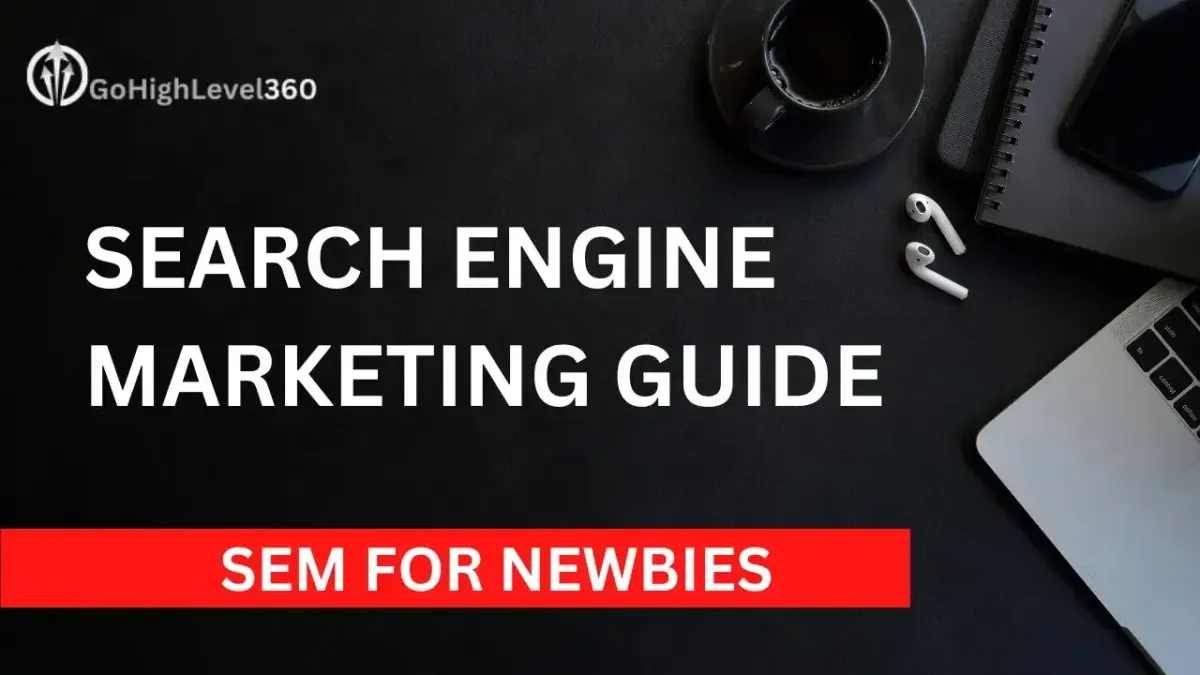Go High Level 360 Search Engine Marketing
Guide For Newbies

Introduction to Search Engine Marketing
What is Search Engine Marketing (SEM)?
At its core, Search Engine Marketing (SEM) is a strategic approach to increase a website's visibility on search engine results pages (SERPs). It's an umbrella term that encompasses both the art of search engine optimization (SEO) and the science of pay-per-click (PPC) advertising. The goal? To ensure your business gets noticed by those who matter most – your potential customers.
Importance of SEM in Today's Digital World
In today's digital age, your online presence or website, is your business card, billboard, and storefront all rolled into one. SEM isn't just about being seen; it's about being discovered at the right moment by the right audience. It bridges the gap between your offerings and those actively seeking them, making it a crucial element of digital marketing.
Table Of Contents
Understanding the Basics of SEM
The Difference Between SEO and SEM
While SEO focuses on optimizing your site to rank higher in organic search results, SEM involves paid advertising campaigns, such as PPC. SEO is a marathon, requiring time and consistent effort, whereas SEM is more of a sprint, offering immediate visibility in the search results.
Key Components of SEM
Successful SEM hinges on several key components:
Keyword Research: Identifying the terms and phrases your potential customers use to search for your products or services.
Ad Creation: Crafting compelling advertisements that resonate with your target audience.
Landing Page Optimization: Ensuring the page your ad links to is relevant, engaging, and designed to convert.
Performance Analysis: Continuously monitoring your campaigns' effectiveness and tweaking as necessary.
Setting Up Your SEM Strategy
Note: Embarking on your SEM journey without a map is like sailing without a compass. Let's chart the course
Defining Your Target Audience
Knowing who you're trying to reach is the first step. Dive into demographic data, interests, and online behavior patterns to paint a picture of your ideal customer.
Keyword Research for SEM
Tools for Keyword Research
Leverage tools like Google's Keyword Planner or SEMrush to discover the keywords your audience is using. These tools also provide insights into the competition level and potential cost per click (CPC) for each keyword.
Analyzing Keyword Competitiveness
Opt for a mix of high-competition keywords for immediate visibility and long-tail, niche keywords that offer higher conversion rates and lower competition.
Creating Compelling Ads
Writing Effective Ad Copy
Your ad copy should be clear, persuasive, and include a strong call-to-action (CTA). Highlight what sets you apart and why the reader should click on your ad.
Choosing the Right Ad Format
Text Ads
Text ads are straightforward and effective, perfect for conveying your message succinctly.
Display Ads
For a more visual approach, display ads can capture attention with graphics and imagery, making them ideal for brand awareness campaigns.
Bidding Strategies and Budget Management
Understanding Bid Strategies
Familiarize yourself with different bidding strategies to find one that aligns with your goals, whether that's maximizing clicks, impressions, or conversions.
Managing Your SEM Budget
Set a budget that allows for testing and optimization. SEM isn't a set-it-and-forget-it strategy; it's a dynamic process that requires adjustment based on performance data.
Measuring and Analyzing Your SEM Performance
Key Performance Indicators (KPIs) for SEM
Track metrics like click-through rate (CTR), conversion rate, and quality score to gauge your campaigns' success and areas for improvement.
Tools for Monitoring SEM Performance
Utilize analytics tools, such as Google Analytics, to dive deep into your SEM campaign's performance, understanding user behavior and optimizing for better results.
Advanced SEM Techniques
Incorporating advanced techniques like remarketing and targeted display ads can significantly enhance your SEM efforts, allowing for more personalized and effective campaigns.
Avoiding Common SEM Mistakes
Common pitfalls include neglecting negative keywords, underestimating the importance of ad extensions, and ignoring mobile users. Steer clear of these to ensure your SEM campaigns thrive.
Future Trends in SEM
Voice search optimization, AI-driven bidding strategies, and increased emphasis on user privacy are just a few trends shaping the future of SEM. Staying ahead means being adaptable and continuously learning.
Conclusion
SEM is a powerful tool in your digital marketing arsenal, capable of propelling your business to new heights. By understanding its components, crafting strategic campaigns, and continuously refining your approach based on data, you can achieve remarkable results. Remember, the digital world is ever-evolving, and so should your SEM strategies.
FAQs
LEGAL
TOOLS
ABOUT
FOLLOW US
HELP
870 Big Buck Run Road
Ft. McKavett, TX, 76841

